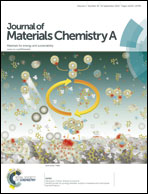Co-sensitization of benzoxadiazole based D–A–π–A featured sensitizers: compensating light-harvesting and retarding charge recombination
Abstract
Triphenylamine (TPA) dyes usually show relatively narrow spectral response range with respect to indoline and porphyrin based dyes. To optimize light-harvesting, WS62 and WS64 are molecularly engineered on the basis of D–A–π–A model. We employ TPA in the absence or presence of long alkoxy-chain as the electron donor, benzoxadiazole as the auxiliary acceptor, a 4H-cyclopenta[2,1-b:3,4-b′]dithiophene (CPDT) unit as the π-bridge, and cyanoacetic acid as the anchor group. The incorporated electron-withdrawing unit of benzoxadiazole enhances light harvesting by decreasing the molecular energy gap and red-shifting absorption spectra. Moreover, three D–π–A-featured dyes (S0, S1 and S2) with different length of the π-bridge are developed as co-sensitizers for WS62 and WS64. As demonstrated, the co-sensitization effect is critically dependent upon the π-conjunction length in the three co-adsorbent dyes. Dye S2 containing dithiophene unit as the π-bridge shows a promising co-sensitization result for enhancing photovoltaic efficiency. In contrast, S1 and S0 with fewer thiophene units negatively contribute to photovoltaic performances. The cocktail co-sensitization of WS62 and WS64 with S2 can compensate the peak valley of IPCE adsorbed by electrolyte near 400 nm and compact the surface of TiO2 to retard charge recombination, essentially for the optimization of photovoltaic performances. Solar cells based on the co-sensitization of WS64 and S2 show a high efficiency of 7.9% (VOC of 738 mV, JSC of 14.9 mA cm−2 and FF of 0.72), exhibiting a significant improvement by 41% compared to the WS64 alone sensitized devices under the same conditions. The charge transfer resistance (RCT) of the co-sensitized DSSCs is larger than that of DSSC comprising only WS62 or WS64 by around 10-fold, indicating that the unfavourable charge transfer from TiO2 to electrolyte is efficiently blocked by the cocktail co-sensitization of S2. These findings pave a way regarding how to choose the proper and matchable co-sensitizers for further increasing the photovoltaic performances of pure organic sensitizers.


 Please wait while we load your content...
Please wait while we load your content...